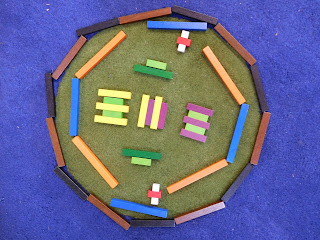We are very lucky at our school to have some great resources.
Some of these may not be so obvious - like the big circle rug on the floor in my room. I decided today that we would use this rug as the base for our patterns.
So when the kids came in, they found I had put some materials in each circle. Some had pattern blocks, some had Cuisenaire rods.
The challenge - make a pattern inside the circle using the materials provided.
Here is what the kids came up with:
Linear Patterns
Bilateral Symmetry
Rotational Symmetry
Interesting the way the kids went about this. Some took quite a while to settle on an idea. Others made several patterns. A few wanted to make pictures - the Mona Lisa, a dog, even the clock was a bit "pictorial" before I probed a bit about the need to make a pattern.
There was very little copying - or "piggy-backing" on the ideas of others. Most of the students had their own creative solutions they wanted to explore.
I was very interested to use this a bit of an assessment moment - how far had we got in two terms?
Results - I was impressed at the spontaneity and individuality of the students. I saw examples of different types of patterns that we had explored already. I was also able to identify a few individuals who struggled to come to terms with the task.
This is our last week before the mid-year break. See you sometime in July.
Oh - and if you are coming to the AAMT conference in Canberra, come and say hello.





























